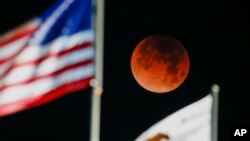ຈັນທະຄາດເຕັມດວງ ຈະແນມເຫັນໄດ້ໃນຊີກໂລກເຂດຕາເວັນຕົກ ໃນຕອນຂ້າມຄືນຂອງວັນພະຫັດມື້ນີ້ ໂດຍຈະເຫັນໄດ້ທີ່ສຸດຢູ່ໃນທະວີບຂອງອາເມຣິກາເໜືອ ແລະອາເມຣິກາໃຕ້.
ນັກສ່ອງເບິ່ງທ້ອງຟ້າທັງຫຼາຍ ໃນທະວີອາຟຣິກາ ແລະເຂດຕ່າງໆຂອງທະວີຢູໂຣບ ຍັງອາດຈະໂຊກດີ ພໍທີ່ໄດ້ເຫັນພຽງເລັກນ້ອຍຂອງປະກົດການເທິງທ້ອງຟ້າດັ່ງກ່າວ.
ຈັນທະຄາດ ເກີດຂຶ້ນເມື່ອດາວໂລກ, ດວງຈັນ ແລະ ດວງຕາເວັນ ໂຄຈອນມາລຽນກັນ ແລ້ວເງົາຂອງດາວໂລກ ທີ່ເກີດຈາກການບັງແສງດວງຕາເວັນ ທີ່ເອີ້ນກັນວ່າ “ກົບກິນເດືອ” ຫຼື ຈັນທະຄາດນັ້ນ.
ດວງຈັນ ຈະເບິ່ງຄືວ່າ ເປັນໜ່ວຍສີທອງແດງໃນທ້ອງຟ້າ ອັນເປັນປະກົດການທີ່ຮູ້ຈັກກັນຄື ເດືອນເລືອດ ຫຼື red moon. ສີຂອງດວງຈັນເປັນຜົນມາຈາກການກັ່ນຕອງຂອງແສງຕາເວັນຜ່ານຊັ້ນບັນຍາກາດຂອງໂລກ.
ນັກສ່ອງເບິ່ງທ້ອງຟ້າ ຈະບໍ່ຈຳເປັນຕ້ອງໃຊ້ອຸປະກອນພິເສດ, ແວ່ນຕາ ຫຼື ສິ່ງຂອງໃດໆ ເພື່ອເບິ່ງຈັນທະຄາດເຕັມດວງຄັ້ງນີ້ ເຖິງແມ່ນວ່າ ກ້ອງສ່ອງຄູ່ ຫຼື ກ້ອງສ່ອງດາວ ຫຼື telescope ອາດຈະສະໜອງການເບິ່ງໄດ້ດີກວ່າສາຍຕາ.
“ຕາບໃດທີ່ທ້ອງຟ້າແຈ້ງສະຫວ່າງ ເຈົ້າກໍ່ສາມາດແນມເຫັນມັນ” ທ່ານນາງ ແຊນນອນ ເຊີໂມລ ຜູ້ອຳນວຍການຂອງ ສູນທ້ອງຟ້າຈຳລອງ ເອບຣຳສ໌ (Abrams Planetarium) ຢູ່ມະຫາວິທະຍາໄລຂອງລັດມິຊິແກັນ ໄດ້ກ່າວຕໍ່ອົງການຂ່າວເອພີ.
ໃນທະວີບອາເມຣິກາເໜືອ ການເບິ່ງໃນເວລາທີ່ດີທີ່ສຸດ ຈະແມ່ນ 2 ໂມງ 59 ນາທີ ຕອນເຊົ້າໝືດ ວັນສຸກທີ 14 ມີນາ ມື້ອື່ນນີ້. ນັ້ນເປັນເວລາທີ່ດາວໂລກ ຢູ່ເລິກສຸດ, ເງົາມືດທີ່ສຸດ - ທີ່ເອີ້ນວ່າ ອຳບຣາ (umbra) ເຊິ່ງຈະຄ່ອຍໆປົກປິດດວງຈັນຈົນທັງໝົດ.
ດວງຈັນຄາດໝາຍວ່າ ຈະຖືກປົກປິດທັງໝົດພາກໃນ 65 ນາທີ ເຖິງຢ່າງໃດກໍ່ຕາມ ຈັນທະຄາດຈະໃຊ້ເວລາປະມານຫົກຊົ່ວໂມງ ໃນປະກົດການຕັ້ງແຕ່ຕົ້ນຈົນສຸດ.
ທ່ານສາມາດເຂົ້າໄປເບິ່ງໄດ້ທີ່ ເວັບໄຊ້: [https://www.timeanddate.com/eclipse/lunar/2025-march-14] ສຳລັບສະຖານທີ່ແຫ່ງໃດ ແລະເມື່ອໃດ ທີ່ຈະເກີດປະກົດການ ດວງຈັນເລືອດ ຈະສາມາດແນມເຫັນໄດ້ ໃນພາກພື້ນຕ່າງໆ ຂອງຊີກໂລກນັ້ນໆ.
ອ່ານຂ່າວນີ້ໃນພາສາອັງກິດ
A total lunar eclipse will be visible in the Western Hemisphere overnight Thursday, with the best views in North America and South America.
Skywatchers in Africa and parts of Europe may also be lucky enough to catch a glimpse of the celestial spectacle.
A lunar eclipse occurs when the Earth, the moon and the sun line up and the Earth’s shadow blocks, or eclipses, the moon.
The moon will look like a coppery red ball in the sky, a phenomenon known as the blood moon. The moon’s color is the result of stray bits of sunlight filtering through Earth's atmosphere.
Skywatchers won’t need any special equipment, glasses or gadgets to see the eclipse – although binoculars or a telescope could provide a better view.
"As long as the sky is clear, you should be able to see it," Shannon Schmoll, director of Abrams Planetarium at Michigan State University, told the Associated Press.
In North America, peak viewing time will be at 2:59 a.m. EDT (6:59 GMT) March 14. That’s when the Earth’s deepest, darkest shadow - the umbra – will cover the moon. The moon is expected to be totally obscured for 65 minutes, although the eclipse will last for about six hours in its entirety.
Check here [https://www.timeanddate.com/eclipse/lunar/2025-march-14] for where and when the blood moon will be visible in different parts of the hemisphere.






ຟໍຣັມສະແດງຄວາມຄິດເຫັນ